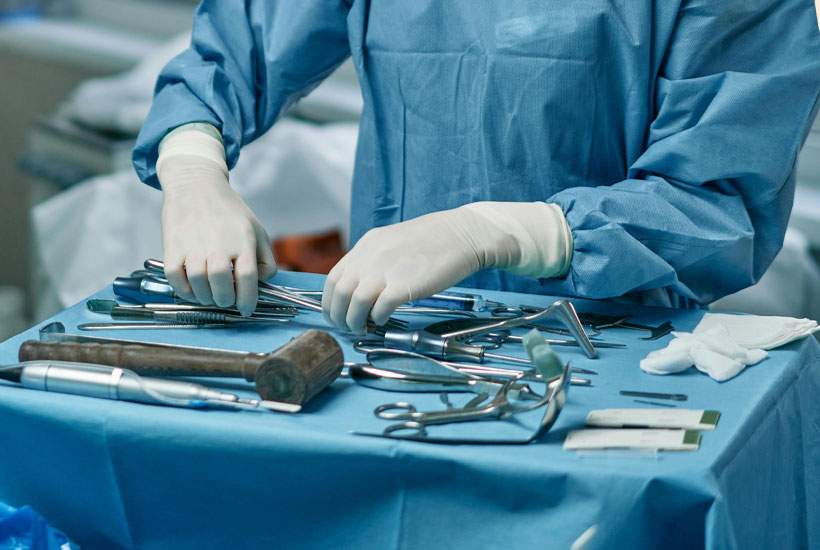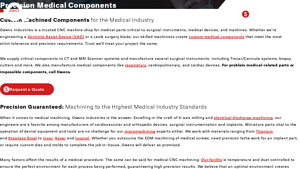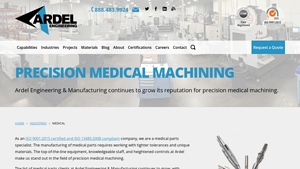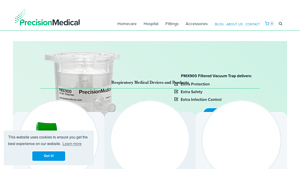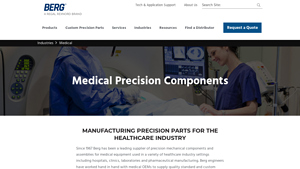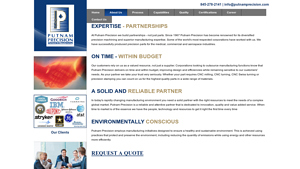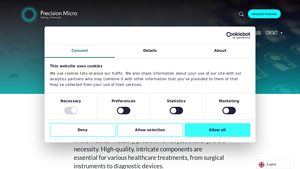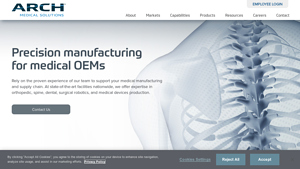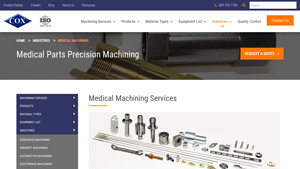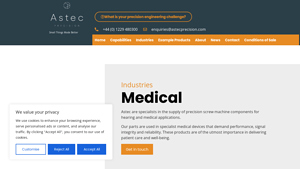Medical Precision Parts Guide: Type, Cost, Top List…
Introduction: Navigating the Global Market for medical precision parts
In the fast-evolving landscape of medical technology, sourcing high-quality medical precision parts can be a daunting challenge for international B2B buyers. The need for components that meet stringent regulatory standards and precise specifications is paramount, especially in regions like Africa, South America, the Middle East, and Europe, where local supply chains may be underdeveloped. This comprehensive guide aims to illuminate the complexities of navigating the global market for medical precision parts, providing invaluable insights into various types of components, their applications, and the critical factors to consider when vetting suppliers.
Buyers will discover essential information on the diverse range of medical precision parts, from surgical instruments to diagnostic equipment, and the specific materials commonly utilized, such as titanium and stainless steel. Additionally, the guide addresses the importance of quality assurance, compliance standards, and cost considerations, ensuring that readers can make informed purchasing decisions. By empowering B2B buyers with actionable knowledge and strategies, this resource will help streamline the procurement process, mitigate risks, and ultimately enhance the quality of medical devices and equipment in their respective markets. The goal is to facilitate a smoother path toward securing reliable and innovative medical components that contribute to improved patient outcomes and operational efficiency.
Understanding medical precision parts Types and Variations
| Type Name | Key Distinguishing Features | Primary B2B Applications | Brief Pros & Cons for Buyers |
|---|---|---|---|
| Surgical Instruments | High precision, tailored designs for specific procedures | Hospitals, surgical centers | Pros: Customizable, high accuracy. Cons: Longer lead times for custom orders. |
| Diagnostic Imaging Components | Components for imaging devices like MRI and CT scanners | Medical imaging centers, hospitals | Pros: Essential for diagnostics, high reliability. Cons: Can be costly due to precision requirements. |
| Implantable Medical Devices | Biocompatible materials, stringent regulatory compliance | Orthopedic, dental, and cardiac applications | Pros: Life-saving applications, high demand. Cons: Complex regulatory hurdles. |
| Lab Equipment Components | Precision parts for laboratory instruments | Research labs, clinical labs | Pros: Vital for accuracy in testing. Cons: Specialized parts may have longer lead times. |
| Micromachined Parts | Extremely small components with tight tolerances | Dental tools, minimally invasive devices | Pros: Essential for advanced procedures, compact designs. Cons: Requires specialized machining capabilities. |
What Are the Key Characteristics of Surgical Instruments in Medical Precision Parts?
Surgical instruments are designed for high precision and tailored to specific procedures, making them crucial in surgical settings. They often include tools like scalpels, forceps, and retractors, which must meet stringent standards for safety and effectiveness. B2B buyers should consider the customization options available, as well as the supplier’s ability to meet tight tolerances and delivery schedules. The complexity of these instruments can lead to longer lead times, which is a critical factor in the procurement process.
How Do Diagnostic Imaging Components Function in the Medical Field?
Diagnostic imaging components are integral to devices such as MRI and CT scanners. These parts require exceptional reliability and precision to ensure accurate imaging results, which are vital for patient diagnosis. Buyers should prioritize suppliers with a proven track record in manufacturing high-quality imaging components and an understanding of regulatory compliance. While these components are essential for effective diagnostics, they can also come with higher costs due to their specialized nature.
What Should B2B Buyers Know About Implantable Medical Devices?
Implantable medical devices, such as orthopedic implants and cardiac stents, are made from biocompatible materials to ensure patient safety. These devices must adhere to strict regulatory requirements, making their production complex and highly specialized. B2B buyers should assess the manufacturer’s experience with regulatory compliance and the ability to produce devices that meet their specific needs. Although these devices are critical for patient care, navigating the regulatory landscape can be challenging.
Why Are Lab Equipment Components Important in Medical Precision Parts?
Lab equipment components play a vital role in ensuring the accuracy and reliability of testing in research and clinical settings. These parts are often used in devices such as centrifuges and analyzers, requiring precision machining to maintain performance standards. Buyers should consider suppliers who can offer a range of materials and who understand the specific requirements of laboratory environments. However, specialized components may lead to longer lead times, so planning ahead is essential.
What Makes Micromachined Parts Unique in Medical Applications?
Micromachined parts are characterized by their extremely small size and the ability to meet tight tolerances, making them essential in advanced medical applications such as dental tools and minimally invasive devices. These components often require specialized machining techniques and equipment, so it’s crucial for buyers to partner with manufacturers experienced in micromachining. While these parts are vital for innovative medical solutions, their specialized nature can lead to increased costs and longer production times.
Key Industrial Applications of medical precision parts
| Industry/Sector | Specific Application of medical precision parts | Value/Benefit for the Business | Key Sourcing Considerations for this Application |
|---|---|---|---|
| Surgical Instruments | Custom machined components for surgical tools | Enhanced precision improves patient outcomes | Compliance with international medical standards |
| Diagnostic Imaging | Components for MRI and CT scanners | Improved diagnostic accuracy and efficiency | Material quality and biocompatibility |
| Implantable Devices | Precision parts for orthopedic implants | Increased patient safety and implant longevity | Traceability and certification of materials used |
| Respiratory Equipment | Valves and components for ventilators | Critical for life-saving applications | Rapid prototyping and emergency response capabilities |
| Laboratory Equipment | Parts for lab analysis tools | Higher accuracy in testing results | Consistency in supply and adherence to ISO standards |
How Are Medical Precision Parts Used in Surgical Instruments?
In the surgical instruments sector, medical precision parts are crucial for creating custom machined components that ensure optimal functionality and safety during procedures. These parts include intricate tools like scalpels, forceps, and retractors, which require precise tolerances to prevent complications. International buyers need to ensure that their suppliers adhere to stringent quality standards, such as ISO certifications, to guarantee that the instruments meet regulatory requirements in their respective countries.
What Role Do Medical Precision Parts Play in Diagnostic Imaging?
Medical precision parts are integral to the functioning of diagnostic imaging equipment, such as MRI and CT scanners. Components like gears, housings, and electronic enclosures must be manufactured with exceptional accuracy to enhance the diagnostic capabilities of these machines. Buyers from diverse regions should prioritize suppliers who can provide high-quality materials and demonstrate compliance with international medical device regulations, ensuring that their imaging systems perform reliably and accurately.
How Are Medical Precision Parts Essential for Implantable Devices?
In the realm of implantable devices, precision parts are vital for orthopedic implants, stents, and pacemakers. These components must be crafted with utmost precision to ensure compatibility with human tissue and to function effectively within the body. B2B buyers must consider sourcing from manufacturers who can provide traceability and certification for their materials, as these factors are critical for patient safety and regulatory compliance in various markets, particularly in Europe and the Middle East.
Why Are Medical Precision Parts Critical in Respiratory Equipment?
Medical precision parts, such as valves and other components for ventilators, play a significant role in respiratory equipment, especially during emergencies. These components must be reliable and manufactured to exact specifications to ensure patient safety and effective operation. Buyers should look for suppliers who can respond quickly to urgent needs and offer rapid prototyping capabilities, ensuring that they have access to critical components when they are most needed.
How Do Medical Precision Parts Enhance Laboratory Equipment?
In laboratory settings, medical precision parts are used in various analytical tools and devices, facilitating accurate testing and research. Components like pipettes, centrifuges, and DNA analysis equipment rely on precision machining to deliver reliable results. For international buyers, maintaining a consistent supply of these parts is essential, and sourcing from manufacturers who adhere to ISO standards can help ensure that the equipment performs consistently over time.
3 Common User Pain Points for ‘medical precision parts’ & Their Solutions
Scenario 1: Inconsistent Quality of Medical Precision Parts
The Problem: B2B buyers in the medical industry often face the challenge of inconsistent quality in the precision parts they procure. This inconsistency can lead to severe consequences, including device malfunctions, increased costs due to rework, and potential risks to patient safety. For instance, if a manufacturer of surgical instruments receives parts that do not meet the required specifications, it can jeopardize the entire surgical procedure, leading to delays and loss of trust in the supplier.
The Solution: To mitigate this risk, buyers should prioritize suppliers with robust quality assurance processes. When sourcing medical precision parts, it’s essential to inquire about the supplier’s quality certifications, such as ISO 13485, which specifically pertains to medical devices. Establishing a partnership with suppliers that utilize advanced manufacturing techniques like CNC machining and have stringent quality control measures in place can enhance product reliability. Furthermore, buyers should consider implementing a thorough inspection process upon receiving components, including dimensional checks and material certifications, to ensure compliance with specified tolerances and standards.
Scenario 2: Difficulty in Customization and Prototyping
The Problem: Many B2B buyers struggle with the customization of medical precision parts, particularly when there is a need for bespoke components tailored to specific medical applications. The challenge lies in finding suppliers capable of efficiently producing small batches of customized parts without incurring prohibitive costs or long lead times. This can be particularly frustrating for companies developing innovative medical devices that require rapid prototyping to bring their products to market.
The Solution: To address this issue, buyers should seek out suppliers that specialize in rapid prototyping and have the capacity for low-volume production runs. Engaging with manufacturers who employ advanced technologies, such as 3D printing or CNC micromachining, can significantly reduce lead times and costs associated with custom parts. When communicating with suppliers, buyers should provide detailed specifications and performance requirements, which can help manufacturers suggest the best materials and processes for the intended application. Additionally, establishing a collaborative relationship with the supplier can facilitate a smoother design iteration process, allowing for quicker adjustments based on feedback.
Scenario 3: Supply Chain Disruptions and Delays
The Problem: In today’s global market, supply chain disruptions pose a significant challenge for B2B buyers of medical precision parts. Factors such as geopolitical tensions, natural disasters, or pandemics can lead to unexpected delays in delivery, affecting production schedules and potentially jeopardizing patient care. For instance, a sudden halt in the supply of critical components can lead to a backlog in manufacturing, impacting the availability of essential medical devices.
The Solution: To combat supply chain vulnerabilities, buyers should diversify their supplier base and consider dual sourcing critical components. This strategy minimizes reliance on a single supplier and ensures that there are alternative options available in case of disruptions. Furthermore, maintaining open lines of communication with suppliers about their inventory levels and production capabilities can provide valuable insights into potential delays. Implementing a just-in-time inventory management system can also help reduce the impact of delays, allowing companies to adjust their production schedules proactively. Lastly, leveraging technology for real-time tracking of orders can enhance visibility and enable better decision-making in response to supply chain challenges.
Strategic Material Selection Guide for medical precision parts
What Are the Key Properties of Titanium for Medical Precision Parts?
Titanium is a highly regarded material in the medical industry, particularly for precision parts due to its excellent strength-to-weight ratio and outstanding corrosion resistance. It can withstand high temperatures and pressures, making it suitable for various medical applications, including implants and surgical instruments. Titanium is biocompatible, which means it can coexist with living tissue without causing adverse reactions, a crucial property for medical devices that come into direct contact with the human body.
Pros and Cons of Using Titanium in Medical Applications
The primary advantages of titanium include its durability and resistance to corrosion, which ensures longevity and reliability in medical applications. However, titanium can be more expensive than other materials, potentially impacting the overall cost of medical devices. The manufacturing process can also be complex due to the material’s hardness, requiring specialized machining techniques that may increase lead times.
How Does Stainless Steel Perform in Medical Precision Parts?
Stainless steel is another popular choice for medical precision parts, known for its excellent mechanical properties and resistance to corrosion. It can withstand sterilization processes, making it ideal for surgical tools and implants. Stainless steel is available in various grades, each tailored for specific applications, allowing for flexibility in design and functionality.
Pros and Cons of Stainless Steel in Medical Applications
The advantages of stainless steel include its affordability and ease of machining compared to titanium. It offers good strength and durability, which are essential for surgical instruments. However, certain grades of stainless steel may not be as biocompatible as titanium, potentially limiting their use in implants. Additionally, while stainless steel is resistant to corrosion, it may not perform as well as titanium in highly corrosive environments.
What Are the Benefits of Using Plastics in Medical Precision Parts?
Plastics, such as PEEK and PTFE, are increasingly used in the medical field due to their lightweight nature and versatility. These materials can be engineered to meet specific performance criteria, including temperature resistance and chemical compatibility. Plastics are often used in applications where metal is not required, such as in certain surgical instruments and disposable medical devices.
Pros and Cons of Plastics in Medical Applications
The primary advantage of plastics is their cost-effectiveness and ease of manufacturing. They can be molded into complex shapes, allowing for innovative designs. However, plastics may not offer the same level of strength or durability as metals, which can limit their use in high-stress applications. Additionally, some plastics may not be suitable for high-temperature sterilization processes.
What Considerations Should International B2B Buyers Keep in Mind When Selecting Materials?
International B2B buyers, particularly from regions like Africa, South America, the Middle East, and Europe, must consider compliance with local and international standards when selecting materials for medical precision parts. Common standards include ASTM, DIN, and JIS, which govern material properties and performance. Additionally, buyers should be aware of the material preferences in their regions, as certain materials may be more readily available or preferred based on local manufacturing capabilities.
| Material | Typical Use Case for medical precision parts | Key Advantage | Key Disadvantage/Limitation | Relative Cost (Low/Med/High) |
|---|---|---|---|---|
| Titanium | Implants, surgical instruments | Excellent corrosion resistance | High manufacturing complexity | High |
| Stainless Steel | Surgical tools, medical devices | Cost-effective and durable | Limited biocompatibility | Medium |
| Plastics | Disposable devices, certain surgical tools | Lightweight and versatile | Lower strength than metals | Low |
In-depth Look: Manufacturing Processes and Quality Assurance for medical precision parts
What Are the Key Stages in the Manufacturing Process of Medical Precision Parts?
The manufacturing of medical precision parts involves several critical stages that ensure the highest quality and precision. Understanding these stages can help B2B buyers make informed decisions when selecting suppliers.
Material Preparation: How Is Raw Material Selected and Processed?
The first stage in the manufacturing process is material preparation. The selection of materials is paramount, with common choices including titanium, stainless steel, and specialized plastics. Each material is chosen based on its mechanical properties, biocompatibility, and ability to withstand sterilization processes.
Once the materials are selected, they undergo several preparatory processes, such as cutting, machining, or heat treatment, to ensure they meet the required specifications. This stage often includes quality checks to confirm that the materials are free from defects and suitable for the intended medical application.
Forming: What Techniques Are Used in the Manufacturing Process?
The forming stage involves transforming raw materials into precise components using various machining techniques. Techniques such as CNC milling, turning, and micromachining are commonly employed to create intricate designs that meet stringent tolerances.
Advanced technologies, such as 5-axis milling and electrical discharge machining (EDM), enable manufacturers to produce complex geometries that are critical in medical devices. The use of CNC Swiss machining allows for high-volume production of small, precise parts, making it an essential method in the medical manufacturing sector.
Assembly: How Are Components Assembled for Medical Devices?
Assembly is a crucial phase where individual components are put together to form a complete medical device or instrument. This process may require specialized equipment and techniques to ensure that parts fit together accurately and function as intended.
Quality control measures are integral during assembly. Manufacturers often implement verification steps to confirm that all components meet specifications before final assembly. This may involve using fixtures or jigs that hold parts in place during the assembly process, ensuring consistency and precision.
Finishing: What Post-Processing Techniques Are Applied?
The finishing stage includes processes such as deburring, polishing, and surface treatment to enhance the final product’s appearance and functionality. This is especially important in the medical field, where the sterility and surface finish of components can significantly impact their performance.
Finishing techniques may also involve coatings that enhance corrosion resistance or improve biocompatibility. Rigorous quality checks are conducted post-finishing to ensure that the final products meet the required standards.
What Quality Assurance Measures Are Essential for Medical Precision Parts?
Quality assurance (QA) is a critical aspect of manufacturing medical precision parts, ensuring that products meet international standards and specific industry requirements.
Which International Standards Should Buyers Look For?
International standards play a vital role in the quality assurance of medical precision parts. The ISO 9001:2015 standard is widely recognized and emphasizes a quality management system that helps organizations ensure they meet customer and regulatory requirements consistently.
Additionally, industry-specific certifications such as CE marking, which indicates conformity with health, safety, and environmental protection standards in Europe, and API standards for medical devices are essential for ensuring product reliability and safety.
What Are the Key Quality Control Checkpoints in the Manufacturing Process?
Quality control checkpoints are integrated throughout the manufacturing process to ensure compliance with specifications. Common checkpoints include:
- Incoming Quality Control (IQC): Inspecting raw materials upon arrival to verify their quality and suitability for production.
- In-Process Quality Control (IPQC): Conducting inspections during the manufacturing process to detect any deviations from specifications early on.
- Final Quality Control (FQC): A thorough inspection of finished products before they are shipped, ensuring they meet all required standards.
These checkpoints help maintain a high level of quality throughout the manufacturing process and are crucial for building trust with B2B buyers.
How Can B2B Buyers Verify Supplier Quality Control Practices?
For B2B buyers, verifying the quality control practices of suppliers is essential to ensure reliable partnerships. Buyers can employ several methods to assess a supplier’s quality assurance processes:
-
Audits: Conducting on-site audits of the supplier’s manufacturing facilities allows buyers to evaluate the quality management systems in place, including their adherence to international standards.
-
Quality Reports: Requesting documentation on quality control practices, including inspection reports and testing results, can provide insights into the supplier’s commitment to quality.
-
Third-Party Inspections: Engaging third-party inspection services can offer an unbiased assessment of the supplier’s products and processes, ensuring they meet the required standards.
What Nuances Should International Buyers Consider Regarding Quality Control?
When dealing with international suppliers, particularly those in regions like Africa, South America, the Middle East, and Europe, buyers should be aware of several nuances related to quality control:
-
Regulatory Compliance: Different regions may have varying regulatory requirements for medical devices. Buyers must ensure that their suppliers comply with local regulations in addition to international standards.
-
Cultural Differences: Understanding cultural approaches to quality assurance can influence how quality is perceived and implemented. Building strong relationships with suppliers can help bridge any gaps.
-
Supply Chain Transparency: International buyers should prioritize suppliers that provide transparency in their supply chain processes, including sourcing materials and manufacturing practices. This transparency is crucial for maintaining quality and accountability.
By understanding the manufacturing processes and quality assurance measures associated with medical precision parts, B2B buyers can make informed decisions that ultimately enhance their product offerings and ensure patient safety.
Practical Sourcing Guide: A Step-by-Step Checklist for ‘medical precision parts’
Introduction
Sourcing medical precision parts requires a meticulous approach due to the critical nature of these components in healthcare applications. This guide provides a step-by-step checklist to help international B2B buyers effectively navigate the procurement process, ensuring they select reliable suppliers who meet industry standards.
Step 1: Define Your Technical Specifications
Clearly outlining your technical specifications is the foundation of sourcing medical precision parts. This includes dimensions, tolerances, materials, and any specific regulatory requirements. By having detailed specifications, you can communicate your needs effectively to potential suppliers, reducing the risk of miscommunication and ensuring that the parts meet your exact requirements.
Step 2: Research and Identify Potential Suppliers
Conduct thorough research to identify suppliers with a proven track record in the medical precision parts sector. Look for companies that specialize in CNC machining and have experience with the specific components you need. Resources such as industry directories, trade shows, and online platforms can provide valuable insights into suppliers’ capabilities and reputations.
Step 3: Evaluate Supplier Certifications
It’s essential to verify that potential suppliers hold relevant certifications, such as ISO 13485 or ISO 9001:2015, which indicate compliance with quality management standards in the medical industry. These certifications assure you that the supplier adheres to strict quality control processes, which is vital for ensuring the reliability and safety of medical components.
Step 4: Request Samples and Conduct Testing
Before making a bulk order, request samples of the medical precision parts for evaluation. Conduct thorough testing to assess quality, functionality, and compliance with your specifications. This step allows you to identify any potential issues early on and ensures that the parts will perform as required in their intended applications.
Step 5: Assess Production Capabilities
Understanding a supplier’s production capabilities is crucial for ensuring they can meet your order volume and delivery timelines. Inquire about their machining processes, equipment, and production capacity. Additionally, assess their ability to scale production if your demand increases, which can prevent future supply chain disruptions.
Step 6: Review Pricing and Payment Terms
Evaluate the pricing structure and payment terms offered by potential suppliers. While cost is an important factor, it should not be the sole consideration; ensure that the price reflects the quality and precision of the parts. Look for transparent payment terms and consider the implications of lead times and shipping costs on your overall budget.
Step 7: Establish Clear Communication Channels
Effective communication is vital throughout the sourcing process. Establish clear channels for ongoing dialogue with your supplier, including updates on production timelines, quality assurance, and any potential issues. A strong communication strategy fosters a collaborative relationship, enabling swift resolution of any challenges that may arise.
By following this checklist, B2B buyers can enhance their sourcing strategies for medical precision parts, ensuring they partner with suppliers who meet high standards of quality and reliability essential for the healthcare industry.
Comprehensive Cost and Pricing Analysis for medical precision parts Sourcing
What Are the Key Cost Components in Medical Precision Parts Sourcing?
When sourcing medical precision parts, understanding the cost structure is crucial for international B2B buyers. The primary components of cost include:
-
Materials: The choice of materials greatly influences cost. Common materials such as titanium and stainless steel are often used due to their biocompatibility and strength. Specialty alloys and plastics can also be utilized depending on the specific application, but these can drive up costs.
-
Labor: Skilled labor is essential in the production of high-precision medical components. The complexity of machining processes, such as CNC turning and micromachining, requires experienced machinists, which can contribute significantly to labor costs.
-
Manufacturing Overhead: This includes the costs associated with running the facility, such as utilities, maintenance, and salaries of support staff. A well-maintained, technologically advanced facility can ensure better precision and lower defect rates, impacting overall manufacturing costs.
-
Tooling: Specialized tooling is often necessary for the production of intricate parts. The initial investment in tooling can be substantial, but it is amortized over the production volume, making it crucial to consider expected order quantities.
-
Quality Control (QC): Given the critical nature of medical components, rigorous QC processes are mandatory. Costs associated with testing, inspections, and certifications (like ISO 9001:2015) can add to the overall expense but are essential for compliance and safety.
-
Logistics: Shipping and transportation costs can vary significantly based on the supplier’s location and the terms of delivery (Incoterms). Efficient logistics management is essential for minimizing delays and ensuring timely delivery.
-
Margin: Suppliers typically include a profit margin that can range widely based on market conditions, competition, and the uniqueness of the product. Understanding the supplier’s pricing strategy can help buyers negotiate better terms.
How Do Price Influencers Impact Medical Parts Sourcing?
Several factors can influence the pricing of medical precision parts:
-
Volume and Minimum Order Quantity (MOQ): Higher order volumes often lead to lower per-unit costs due to economies of scale. Discussing flexible MOQs with suppliers can lead to better pricing structures.
-
Specifications and Customization: Custom parts with unique specifications usually come at a premium. Buyers should assess whether standard parts meet their needs to avoid unnecessary costs.
-
Materials and Quality Certifications: The type of materials used and the certifications required (e.g., FDA approval) can significantly affect pricing. High-quality materials and certifications often justify higher costs due to the reduced risk of failure.
-
Supplier Factors: The supplier’s reputation, experience, and capabilities can influence pricing. Established suppliers with advanced capabilities may charge more but can provide higher reliability and quality assurance.
-
Incoterms: Understanding the terms of delivery can impact total costs. Buyers should clarify responsibilities for shipping, insurance, and customs duties to avoid unexpected charges.
What Are the Best Tips for Negotiating Medical Parts Prices?
For international buyers, particularly from regions like Africa, South America, the Middle East, and Europe, effective negotiation strategies can lead to significant cost savings:
-
Total Cost of Ownership (TCO): Instead of focusing solely on initial purchase price, consider the TCO, which includes maintenance, logistics, and potential downtime costs. This holistic view can help justify investments in higher-quality components.
-
Build Relationships: Establishing long-term relationships with suppliers can lead to better pricing and terms. Frequent communication and transparency can foster trust, making suppliers more willing to negotiate.
-
Leverage Multiple Quotes: Obtaining quotes from several suppliers can provide leverage in negotiations. It helps buyers understand the market price range and identify competitive offers.
-
Be Open to Alternatives: Flexibility in material choices or part designs can open doors to cost-effective solutions. Suppliers may offer alternatives that meet quality standards while reducing costs.
-
Understand Local Market Conditions: Being aware of economic factors, currency fluctuations, and local regulations can provide insights into pricing dynamics, enabling smarter negotiations.
Conclusion
Navigating the complexities of sourcing medical precision parts requires a thorough understanding of cost components and pricing influencers. By employing strategic negotiation tactics and maintaining a focus on the total cost of ownership, international B2B buyers can secure favorable terms and enhance their procurement efficiency. Always approach pricing discussions with a clear understanding of your specific needs and the potential for long-term partnerships with suppliers.
Alternatives Analysis: Comparing medical precision parts With Other Solutions
Understanding Alternatives to Medical Precision Parts
In the competitive landscape of medical manufacturing, organizations often seek alternative solutions to medical precision parts to achieve similar objectives. This analysis examines how medical precision parts stack up against other viable options, such as additive manufacturing and off-the-shelf components. Understanding these alternatives allows B2B buyers to make informed decisions that align with their operational needs and budget constraints.
Comparison of Medical Precision Parts Against Alternatives
| Comparison Aspect | Medical Precision Parts | Additive Manufacturing | Off-the-Shelf Components |
|---|---|---|---|
| Performance | High precision; custom designs | Variable precision; depends on technology used | Standardized performance; less tailored |
| Cost | Higher initial investment | Potentially lower for low-volume runs | Generally lower; cost-effective for mass production |
| Ease of Implementation | Requires specialized skills; longer lead times | Rapid prototyping; easier for complex geometries | Straightforward integration; ready to use |
| Maintenance | Regular quality checks; precision required | Minimal for printed parts; varies based on application | Low; typically replaceable parts |
| Best Use Case | Critical components requiring exact specifications | Prototyping and low-volume custom parts | High-volume production with standard specifications |
Detailed Breakdown of Alternatives
Additive Manufacturing
Additive manufacturing, commonly known as 3D printing, offers a flexible approach to producing components. Its strength lies in rapid prototyping and the ability to create complex geometries that may be challenging with traditional methods. The initial investment can be lower for low-volume runs, making it an attractive option for startups or companies testing new designs. However, the precision can vary significantly depending on the technology used, which may not meet the stringent requirements of certain medical applications. Additionally, while maintenance is typically low, the long-term durability of printed components can be a concern in high-stress environments.
Off-the-Shelf Components
Utilizing off-the-shelf components is a common practice for many manufacturers looking to reduce costs and expedite the production process. These components are generally less expensive and readily available, making them ideal for high-volume production where customization is not critical. The ease of implementation is a notable advantage, as these parts can be quickly integrated into existing systems. However, the lack of customization may lead to limitations in performance and adaptability, especially in specialized medical applications where precise specifications are paramount.
How to Choose the Right Solution for Your Needs
When selecting the appropriate solution, B2B buyers should consider their specific operational requirements, budget constraints, and the desired performance levels. Medical precision parts are ideal for applications demanding high accuracy and customization, while additive manufacturing can be a game-changer for rapid prototyping and complex designs. On the other hand, off-the-shelf components may provide a cost-effective solution for standard needs. Ultimately, a thorough assessment of each option’s strengths and weaknesses will guide buyers in making decisions that best serve their business objectives and ensure compliance with industry standards.
Essential Technical Properties and Trade Terminology for medical precision parts
What Are the Key Technical Properties of Medical Precision Parts?
When sourcing medical precision parts, understanding critical specifications is vital for ensuring product reliability and compliance with industry standards. Here are some essential properties to consider:
1. Material Grade
The choice of material is fundamental in medical applications, directly affecting the performance and safety of devices. Common materials include titanium, stainless steel, and specialized plastics. Each material offers different benefits, such as corrosion resistance, biocompatibility, and strength. For example, titanium is favored for implants due to its excellent strength-to-weight ratio and compatibility with human tissues.
2. Tolerance
Tolerance refers to the allowable deviation from a specified dimension. In the medical field, tight tolerances (often in the range of ±0.001 mm) are crucial for ensuring the precise fit and function of components, especially in surgical instruments and implants. High precision reduces the risk of malfunction and enhances the safety and effectiveness of medical devices.
3. Surface Finish
The surface finish of medical parts can significantly impact their performance and sterility. A smoother finish minimizes friction and wear, which is critical in devices that will be inserted into the body. Additionally, specific surface treatments can enhance corrosion resistance, which is especially important in devices exposed to bodily fluids.
4. Sterilization Compatibility
Medical components often require sterilization before use to prevent infection. Understanding the sterilization methods compatible with the materials used in precision parts—such as autoclaving, gamma radiation, or ethylene oxide—is essential for ensuring that parts can be safely used in a clinical setting without degrading performance.
5. Mechanical Properties
Mechanical properties such as tensile strength, yield strength, and fatigue resistance are crucial for medical components that undergo repeated stress or loading. These properties ensure that parts can withstand operational demands without failure, which is vital for patient safety.
What Are Common Trade Terms in the Medical Precision Parts Industry?
Familiarity with industry jargon can enhance communication and streamline procurement processes. Here are several key terms frequently used in the medical precision parts sector:
1. OEM (Original Equipment Manufacturer)
An OEM is a company that produces parts or equipment that may be marketed by another manufacturer. In the medical field, OEMs supply components to device manufacturers, ensuring they meet specific design and regulatory requirements.
2. MOQ (Minimum Order Quantity)
MOQ refers to the smallest quantity of a product that a supplier is willing to sell. Understanding MOQs is essential for B2B buyers to manage inventory effectively and negotiate better pricing terms. Lower MOQs may be beneficial for smaller manufacturers or startups.
3. RFQ (Request for Quote)
An RFQ is a document sent to suppliers requesting a price quote for specific products or services. Issuing an RFQ allows buyers to compare pricing and terms from multiple suppliers, facilitating informed purchasing decisions.
4. Incoterms (International Commercial Terms)
Incoterms are standardized trade terms that define the responsibilities of buyers and sellers in international transactions. Familiarity with these terms helps clarify shipping responsibilities, risk transfer, and costs associated with the delivery of medical precision parts.
5. PPAP (Production Part Approval Process)
PPAP is a standardized process used in the automotive and manufacturing industries to ensure that suppliers can meet the required specifications before full-scale production. In the medical field, PPAP compliance is critical to confirm that precision parts meet safety and quality standards.
By understanding these technical properties and trade terminologies, B2B buyers can make more informed decisions when sourcing medical precision parts, ultimately ensuring better outcomes for their products and patients.
Navigating Market Dynamics and Sourcing Trends in the medical precision parts Sector
What Are the Key Trends Influencing the Medical Precision Parts Market?
The global medical precision parts market is currently experiencing significant growth, driven by advancements in healthcare technology and an increasing demand for high-quality medical devices. Key drivers include the rise of minimally invasive surgical procedures, the growing prevalence of chronic diseases, and the rapid development of innovative medical technologies. These factors are compelling manufacturers to seek precise and reliable components to enhance the performance and safety of medical devices.
Emerging technologies such as 3D printing and AI-driven manufacturing processes are reshaping sourcing trends within the industry. 3D printing allows for rapid prototyping and the production of complex geometries, enabling manufacturers to respond quickly to market demands. Additionally, AI and machine learning technologies are streamlining supply chain operations, enhancing quality control, and improving predictive maintenance, which can significantly reduce downtime and costs.
For international B2B buyers, particularly those from regions such as Africa, South America, the Middle East, and Europe, understanding these dynamics is crucial. Buyers must be aware of regional regulations, quality standards, and supply chain logistics that may affect sourcing decisions. Establishing partnerships with suppliers who have a proven track record in compliance and quality assurance will be critical for success in these diverse markets.
How Is Sustainability Impacting Sourcing Decisions for Medical Precision Parts?
Sustainability is becoming a pivotal concern in the medical precision parts sector, influencing sourcing decisions among B2B buyers. Companies are increasingly recognizing the environmental impact of manufacturing processes and are seeking to minimize their carbon footprints. This shift has led to a greater emphasis on ethical sourcing practices, which prioritize suppliers that adhere to sustainable manufacturing processes.
Incorporating ‘green’ certifications and materials is essential for companies looking to establish a responsible supply chain. Utilizing materials such as biocompatible plastics, recycled metals, and eco-friendly coatings not only reduces environmental impact but also aligns with the growing consumer demand for sustainable products. Moreover, suppliers with certifications like ISO 14001 are preferred as they demonstrate a commitment to environmental management.
Ethical sourcing extends beyond materials to include labor practices and supply chain transparency. Buyers must ensure that their suppliers maintain fair labor practices and are compliant with international labor standards. By prioritizing sustainability and ethical sourcing, B2B buyers can enhance their brand reputation, meet regulatory requirements, and appeal to a growing base of environmentally conscious consumers.
What Is the Historical Evolution of the Medical Precision Parts Industry?
The medical precision parts industry has evolved significantly over the past few decades. Initially, manufacturing was characterized by traditional machining methods that often resulted in variability and limited precision. However, the advent of CNC (Computer Numerical Control) machining revolutionized the sector by introducing automated processes that could achieve tighter tolerances and higher accuracy.
As medical devices became more complex, the demand for precision components surged, leading to the development of specialized machining techniques such as micromachining and 5-axis milling. These technologies enabled manufacturers to produce intricate parts essential for advanced medical applications, including surgical instruments and implantable devices.
In recent years, the industry has also embraced digital transformation, integrating advanced technologies such as IoT (Internet of Things) and AI into manufacturing processes. This evolution has not only improved efficiency but has also enhanced quality control measures, ensuring that medical precision parts meet the stringent requirements of the healthcare sector.
Through this historical lens, it is clear that the medical precision parts industry continues to adapt to the changing landscape of healthcare, driven by technological advancements and an increasing focus on quality, sustainability, and ethical practices.
Frequently Asked Questions (FAQs) for B2B Buyers of medical precision parts
1. How do I ensure the quality of medical precision parts from suppliers?
To guarantee the quality of medical precision parts, conduct thorough supplier vetting. Look for manufacturers with ISO certifications, particularly ISO 9001:2015, which indicates a commitment to quality management systems. Request samples to evaluate workmanship and adherence to specifications. Additionally, establish a quality assurance process that includes regular audits and compliance checks to monitor the supplier’s performance over time.
2. What are the most common materials used in medical precision parts manufacturing?
Medical precision parts are typically manufactured using high-grade materials such as titanium, stainless steel, and various biocompatible plastics. Titanium is favored for its strength and corrosion resistance, while stainless steel is known for its durability and ease of sterilization. Understanding the specific requirements of your medical application will help you select the best material that meets both performance and regulatory standards.
3. How can I customize medical precision parts for my specific needs?
Customization of medical precision parts often involves collaboration with your supplier during the design phase. Provide detailed specifications, including dimensions, tolerances, and material preferences. Suppliers with advanced machining capabilities, such as CNC and micromachining, can accommodate complex designs. Utilize CAD models to communicate your requirements effectively, ensuring that the final product meets your expectations.
4. What is the minimum order quantity (MOQ) for medical precision parts?
Minimum order quantities can vary significantly based on the supplier and the complexity of the parts. Some manufacturers may offer low MOQs for standard components, while custom parts often require higher quantities to justify setup costs. Discuss your project needs with potential suppliers to negotiate MOQs that align with your production requirements, especially if you are sourcing for a new product line.
5. What payment terms should I expect when sourcing medical precision parts internationally?
Payment terms can vary widely among suppliers and regions. Common practices include upfront deposits, net 30 or net 60 payment terms, and payment through letters of credit for larger orders. It’s crucial to negotiate terms that protect both parties, considering factors like the supplier’s reputation and your company’s financial capabilities. Establishing clear agreements will help prevent misunderstandings and ensure smooth transactions.
6. How do I handle logistics and shipping for international orders of medical precision parts?
Managing logistics for international orders requires careful planning. Engage a logistics partner experienced in handling medical components to ensure compliance with regulations and timely delivery. Evaluate shipping options, considering factors like cost, speed, and customs clearance. It’s also wise to confirm that the supplier can provide necessary documentation, such as certificates of compliance and material safety data sheets, to facilitate smooth customs processes.
7. What certifications should I look for in suppliers of medical precision parts?
When sourcing medical precision parts, prioritize suppliers with relevant certifications such as ISO 13485, which indicates compliance with quality management systems for medical devices. Additional certifications like FDA registration for U.S. suppliers or CE marking for European markets can also provide assurance of quality and safety standards. These certifications demonstrate the supplier’s commitment to maintaining high-quality production practices.
8. How can I assess the reliability of a supplier for medical precision parts?
To assess a supplier’s reliability, examine their track record, client testimonials, and case studies. Request references from other businesses in your industry to gauge their satisfaction with the supplier’s performance. Additionally, inquire about the supplier’s experience with similar projects and their capacity to meet deadlines. Conducting factory visits or virtual audits can also provide insights into their operational capabilities and quality control processes.
Important Disclaimer & Terms of Use
⚠️ Important Disclaimer
The information provided in this guide, including content regarding manufacturers, technical specifications, and market analysis, is for informational and educational purposes only. It does not constitute professional procurement advice, financial advice, or legal advice.
While we have made every effort to ensure the accuracy and timeliness of the information, we are not responsible for any errors, omissions, or outdated information. Market conditions, company details, and technical standards are subject to change.
B2B buyers must conduct their own independent and thorough due diligence before making any purchasing decisions. This includes contacting suppliers directly, verifying certifications, requesting samples, and seeking professional consultation. The risk of relying on any information in this guide is borne solely by the reader.
Top 9 Medical Precision Parts Manufacturers & Suppliers List
1. Owens Industries – Precision CNC Components for Medical Devices
Domain: owensind.com
Registered: 1996 (29 years)
Introduction: Owens Industries specializes in precision CNC components for the medical industry, including custom machined components for surgical instruments, medical devices, and machines. Key products include: Ventricle Assist Devices (VAD), Lasik surgery blades, CT and MRI scanner components, Trocar/Cannula systems, biopsy cutters, respiratory devices, cardiopulmonary devices, and cardiac devices. The compa…
2. Ardel Engineering – Precision Medical Machining
Domain: ardelengineering.com
Registered: 1997 (28 years)
Introduction: Ardel Engineering & Manufacturing specializes in precision medical machining, offering services for manufacturing medical parts with tighter tolerances and unique materials. They are ISO 9001:2015 certified and ISO 13485:2008 compliant. Their equipment includes Haas CNC machining centers and Citizen Swiss screw machines, enabling them to produce components for hospital equipment, blood purificatio…
3. Precision Medical – PMX900 Filtered Vacuum Trap
Domain: precisionmedical.com
Registered: 1996 (29 years)
Introduction: PMX900 Filtered Vacuum Trap: Extra Protection, Extra Safety, Extra Infection Control. PMX Large Gauge Vacuum Regulators: 50% larger than PM Series gauge for easy visibility of suction pressure. Respiratory Medical Devices: Fittings, Hose Configurator, Flowmeters, Vacuum Regulators, Medical Blenders, Aspirators, Medical Air Compressors, Monitors, Oxygen Concentrators, Oxygen Conservers, Oxygen Regu…
4. WMBerg – Precision Machined Medical Parts
Domain: wmberg.com
Registered: 1996 (29 years)
Introduction: Precision Machined Medical Parts including: Assemblies, Cams, Gearboxes, Geneva Mechanisms, Lead Screw Assemblies, Linear Ball Slides, Linear Roller Slides, Ratchets & Pawls, Belts & Chains, Aircraft Cables, Flex-E-Belt, Flex-E-Gear, Flex-E-Grip, Flex-E-Pitch, Max-M-Drive, Min-E-Pitch, O-Ring Belts & Cords, Pow-R-Vee, Row-L-ER Sprockets, 3D Sprockets, Belt Sprockets, Chain Sprockets, Double Sprock…
5. Putnam Precision – Medical & Aerospace Parts
Domain: putnamprecision.info
Registered: 2012 (13 years)
Introduction: Medical Precision Parts, CNC milling, CNC turning, CNC Swiss turning, precision stamping, suitable for medical, commercial, and aerospace industries, high-quality parts, diverse materials, ISO 9001 Certification, FDA Registration, established in 1967, focus on partnerships, on-time delivery, within budget, environmentally conscious manufacturing practices.
6. Precision Micro – Chemical Etching Services
Domain: precisionmicro.com
Registered: 2001 (24 years)
Introduction: Precision Micro offers chemical etching services for medical precision parts, utilizing photochemical etching technology to produce burr-free, stress-free components with high accuracy and intricate designs. The process accommodates various metals in thicknesses from 0.01 mm to 2.5 mm, allowing for optimal material selection based on strength-to-weight ratios, biocompatibility, and corrosion resis…
7. ARCH Medical Solutions – MedTorque Products
Domain: arch-medical.com
Registered: 2021 (4 years)
Introduction: ARCH Medical Solutions specializes in contract manufacturing for medical OEMs, offering precision manufacturing services across various markets including Orthopedics, Surgical Robotics, Life Sciences, and Dental. Key products include:
1. **MedTorque Products**:
– Silicone-Handle Components
– Silicone Handles (Fixed and Ratcheting Couplings)
– Torque-Limiting Silicone Handles
– Spinal …
8. Cox Manufacturing – Precision Machining Solutions
Domain: coxmanufacturing.com
Registered: 2003 (22 years)
Introduction: Cox Manufacturing Company specializes in precision machining for medical parts, offering services such as Swiss Machining, Micromachining, Multi-Spindle Machining, Automatic Bar Machining, CNC Mill/Turn, CNC Milling, CNC Turning, Precision Machining, Production Wire EDM, Custom Machining, and High Volume Screw Machining. Key products include Screw Machined Pins and Retractable Pins, with materials…
9. Astec Precision – Screw Machine Components for Medical Devices
Domain: astecprecision.com
Registered: 2005 (20 years)
Introduction: Astec specializes in the supply of precision screw machine components for hearing and medical applications. Example products include: Arcap Fibre Optic Body, Nickel Silver Socket Contact, Brass Body, and Small Beryllium Copper Sockets. These parts are used in specialist medical devices that require performance, signal integrity, and reliability, which are critical for patient care and well-being.
Strategic Sourcing Conclusion and Outlook for medical precision parts
In navigating the complex landscape of medical precision parts, strategic sourcing emerges as a pivotal element for success. By aligning with reliable suppliers who adhere to stringent quality standards—such as ISO certifications—international B2B buyers can ensure the delivery of high-quality components critical to medical devices and surgical instruments. Leveraging advanced machining technologies, including CNC and micromachining, not only enhances precision but also fosters innovation in product development.
For businesses in Africa, South America, the Middle East, and Europe, the importance of fostering strong supplier relationships cannot be overstated. These connections facilitate timely responses to market demands and enable the adaptation to evolving regulatory requirements. As the healthcare sector continues to expand, the need for precision and reliability in medical components will only intensify.
Looking ahead, now is the time for buyers to reassess their sourcing strategies. By prioritizing partnerships with manufacturers known for their expertise in medical machining, companies can position themselves for success in an increasingly competitive market. Engage with trusted suppliers today to drive innovation and ensure the highest standards in medical precision parts.
